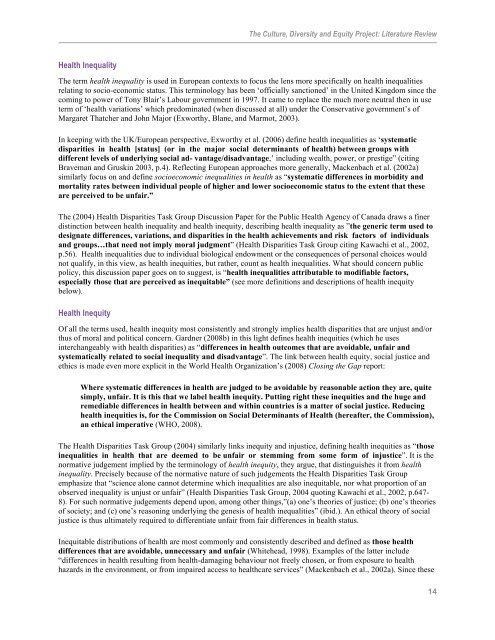CDE Appendix 1 Literature Review - Central East Local Health ...
CDE Appendix 1 Literature Review - Central East Local Health ...
CDE Appendix 1 Literature Review - Central East Local Health ...
Create successful ePaper yourself
Turn your PDF publications into a flip-book with our unique Google optimized e-Paper software.
The Culture, Diversity and Equity Project: <strong>Literature</strong> <strong>Review</strong><br />
<strong>Health</strong> Inequality<br />
The term health inequality is used in European contexts to focus the lens more specifically on health inequalities<br />
relating to socio-economic status. This terminology has been ‘officially sanctioned’ in the United Kingdom since the<br />
coming to power of Tony Blair’s Labour government in 1997. It came to replace the much more neutral then in use<br />
term of ‘health variations’ which predominated (when discussed at all) under the Conservative government’s of<br />
Margaret Thatcher and John Major (Exworthy, Blane, and Marmot, 2003).<br />
In keeping with the UK/European perspective, Exworthy et al. (2006) define health inequalities as ‘systematic<br />
disparities in health [status] (or in the major social determinants of health) between groups with<br />
different levels of underlying social ad- vantage/disadvantage,’ including wealth, power, or prestige” (citing<br />
Braveman and Gruskin 2003, p.4). Reflecting European approaches more generally, Mackenbach et al. (2002a)<br />
similarly focus on and define socioeconomic inequalities in health as “systematic differences in morbidity and<br />
mortality rates between individual people of higher and lower socioeconomic status to the extent that these<br />
are perceived to be unfair.”<br />
The (2004) <strong>Health</strong> Disparities Task Group Discussion Paper for the Public <strong>Health</strong> Agency of Canada draws a finer<br />
distinction between health inequality and health inequity, describing health inequality as ”the generic term used to<br />
designate differences, variations, and disparities in the health achievements and risk factors of individuals<br />
and groups…that need not imply moral judgment” (<strong>Health</strong> Disparities Task Group citing Kawachi et al., 2002,<br />
p.56). <strong>Health</strong> inequalities due to individual biological endowment or the consequences of personal choices would<br />
not qualify, in this view, as health inequities, but rather, count as health inequalities. What should concern public<br />
policy, this discussion paper goes on to suggest, is “health inequalities attributable to modifiable factors,<br />
especially those that are perceived as inequitable” (see more definitions and descriptions of health inequity<br />
below).<br />
<strong>Health</strong> Inequity<br />
Of all the terms used, health inequity most consistently and strongly implies health disparities that are unjust and/or<br />
thus of moral and political concern. Gardner (2008b) in this light defines health inequities (which he uses<br />
interchangeably with health disparities) as “differences in health outcomes that are avoidable, unfair and<br />
systematically related to social inequality and disadvantage”. The link between health equity, social justice and<br />
ethics is made even more explicit in the World <strong>Health</strong> Organization’s (2008) Closing the Gap report:<br />
Where systematic differences in health are judged to be avoidable by reasonable action they are, quite<br />
simply, unfair. It is this that we label health inequity. Putting right these inequities and the huge and<br />
remediable differences in health between and within countries is a matter of social justice. Reducing<br />
health inequities is, for the Commission on Social Determinants of <strong>Health</strong> (hereafter, the Commission),<br />
an ethical imperative (WHO, 2008).<br />
The <strong>Health</strong> Disparities Task Group (2004) similarly links inequity and injustice, defining health inequities as “those<br />
inequalities in health that are deemed to be unfair or stemming from some form of injustice”. It is the<br />
normative judgement implied by the terminology of health inequity, they argue, that distinguishes it from health<br />
inequality. Precisely because of the normative nature of such judgements the <strong>Health</strong> Disparities Task Group<br />
emphasize that “science alone cannot determine which inequalities are also inequitable, nor what proportion of an<br />
observed inequality is unjust or unfair” (<strong>Health</strong> Disparities Task Group, 2004 quoting Kawachi et al., 2002, p.647-<br />
8). For such normative judgements depend upon, among other things,”(a) one’s theories of justice; (b) one’s theories<br />
of society; and (c) one’s reasoning underlying the genesis of health inequalities” (ibid.). An ethical theory of social<br />
justice is thus ultimately required to differentiate unfair from fair differences in health status.<br />
Inequitable distributions of health are most commonly and consistently described and defined as those health<br />
differences that are avoidable, unnecessary and unfair (Whitehead, 1998). Examples of the latter include<br />
“differences in health resulting from health-damaging behaviour not freely chosen, or from exposure to health<br />
hazards in the environment, or from impaired access to healthcare services” (Mackenbach et al., 2002a). Since these<br />
14

















